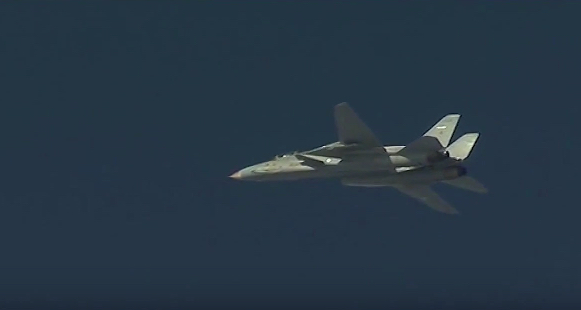
Posted on 11/20/2015 7:10:21 PM PST by sukhoi-30mki

Something really interesting details have been exposed by the material released by Russia’s MoD lately.
Indeed, as you can see in the video below, IRIAF (Islamic Republic of Iran Air Force) F-14 Tomcat interceptors escorted Russian Air Force Tu-95 Bear bombers flying in Iranian airspace during their 9h 30mins missions (from Engels airbase and back, along the Iraq-Iran-Caspian Sea 6,500 km-long corridor) against terrorist targets in Syria.
With the U.S. Navy retiring the legendary F-14 in September 2006, nowadays the IRIAF is the only operator of the Tomcat, a type of aircraft that Tehran has kept airworthy throughout the years in spite of the embargo imposed after the 1979 Revolution.
Not only did the Iranians keep some F-14s in active service but they have also upgraded it with some domestic avionics upgrades and weapons that should extend the life of the last flying Tomcats until 2030.
It was my understanding from a `Foreign Policy’ political science class during that time period that the US specifically withheld vital spare parts and used their supply as leverage to make sure the country buying the armaments listened carefully to our suggestions and advice.
Of course that may have changed under Peanuts.
“WHEN WE SELL THIS TYPE OF EQUIPMENT TO ANYONE...why don’t we build in a mechanism whereby we can destroy it???”
in a manner of speaking they did. After the American contractors were evacuated from Iran, it was discovered some of the critical electronics systems no longer functioned properly anymore, so even when the aircraft could fly again, they lacked the sophisticated electronics needed to make them much better than flying targets. With help from American adversaries, the Iranians have been able to rectify many of those problems over many years, but the number of operational F-14 aircraft are strictly limited and are still poor in capabilities in relation to current air superiority fighter aircraft.
If the Russians are sending in Bears to combat ISIS, they are serious about winning.
But everyone, and I mean everyone, loves a Tomcat.
If they’re carpet bombing, yeah, nothing like Arc-light.
Giap admitted in the years following the Vietnam war that our B-52s were the weapons they feared most.
And no soft jungle and canopy here, just rocks and hard pan. We really hurt the Taliban in 2002-2003 Afghanistan with high altitude bomb strikes.
On September 1, I wrote the following reply alerting us to a really dangerous axis emerging in which we had Russian air power flying about in Syria at will. Now we have Iranians and Russians together flying from one end of this axis to the other in effect proclaiming that they own all this airspace. Now we have the French cooperating with the Russians and by extension also with the Iranians. The implications are very ominous and far more serious than posed by Isis.
Here is that reply:
Consider the implications:
Assad is supported by Teheran
Tehran supported by Moscow
Assad is now openly and militarily supported by Moscow
We have a Moscow/Teheran/Damascus axis
The participation of Russian warplanes in active combat suggests that the Russians are in Syria to stay. They certainly will have an airbase from which they can strike Israel and change the balance of power in the region. Expect them to become active in bombing Isis in Iraq as well, thus extending the Iran's hold over Iraqi the more.
The Russians are already being accommodated in a Mediterranean port by the Syrians and the airpower only compliments the Naval element, protects it, and augments it.
The presence of Russian warplanes in the area makes it much less likely that a new Republican president will strike militarily against Iran's nuclear facilities. Likewise, the Israelis have a new dimension on their flank should they choose to strike.
The entire balance of power will now shift toward the new Moscow/Tehran/Damascus axis which will be armed with nuclear capacity in Damascus, or potentially so, with Russian warplanes and very soon on the eastern Teheran edge with the same.

The Curtiss JN-4 Jenny wooden and fabric biplane was an American built trainer aircraft built during the First World War beginning in 1915, and it was too poor in performance in 1917-1918 to fly against almost any fighter aircraft in use during those years. Its maximum speed was 75 mph, and its cruising speed was 60 mph.
The North American P-51 fighter aircraft and metal monoplane construction produced in the period 1942 and later operated at speeds from a maximum of around 437 mph and cruising at 362 mph.
Upgrade as they will, an Iranian F-14 is to an F-22 as a Curtiss JN-4 would be to a P-51D.
“This policy was coordinated with the Cold War policy to keep the Soviet Union and Communism out of Iran.”
Worked well. Islamists took over!
Quotes below are from this article and note it says 1973; Carter did not become president until January 20, 1977. — http://theaviationist.com/2013/02/11/shah-tomcat/
“In fact, 80 F-14s were ordered by the Shah and 79 were effectively delivered. The procurement of the Tomcat to Iran was very important not only for Grumman, which was facing serious cash flow problems due to the difficult development of the aircraft, but also for the future of the fighter itself, since at the time F-14’s program was affected by schedule slippage and cost overruns.
When the Shah announced his intention to replace the old F-4 Phantoms in service with the Imperial Iranian Air Force, it was clear that both the USAF’s new F-15 and the Navy’s F-14 would have had the same opportunity to become Iranian’s main fighter.
So, after briefings held by USAF and Navy personnel in the Shah’s palace in Tehran, Iranian officials decided that it would have been the flight demonstration at Andrews Air Force Base, near Washington DC, scheduled in July 1973, to determine which one between the two fighters, would be the best to satisfy the then Imperial Iranian Air Force’s requiremens.
The flight demonstration was scheduled not to exceed 30 minutes from the first take off to the landing of the second aircraft.
The base was closed for that short time in which at the presence of the Shah, the two U.S. fighters had to fly their demonstration: it was decided that the USAF’s F-15, piloted by Irv Burrows (McDonnell Douglas’ test pilot), would have performed first, while Don Evans and Dennis Romano (Grumman’s test crew) with their F-14, would wait their turn after the Eagle.”
If you say so.
I just don’t believe that there is any way they are flying them without access to US spare parts.
No way.
What they taught you was a half truth. The purchaser knows the U.S. would like to hold them hostage to U.S. policies, but they refuse to enter into such a contract unless they can secure at least enough logistical supplies to make it worthwhile to enter into such an arrangement with the U.S. The U.S. “sometimes” makes an effort to limit the ability of the customer to go it alone without the U.S. as a supplier for the fleet, but doing so has to be balanced to the minimums acceptable to the customer in the contract. The class was being misled about the extent to which such policies could realistically be implemented in a given case. When we were training the Iranian air force personnel, their training was or was not identical to our own training, depending upon the extent of the security required for that occupational field.
Unlike the Air Forces F-15, the F-14 was something of a white elephant that required extensive maintenance especially as it aged.
It was intended to be the launch platform for the long range Phoenix air to air missile that never actually hit anything when finally used in combat back in the gulf war.
I think they bought a few back before Jimmy Carter felt offended by the Shah.
It reads like the people that build the F-22 agree with you.
http://www.f22-raptor.com/technology/index.html
Have you ever been to the Air Force museum there in Dayton?
If not, it’s well worth the trip.
If you ask the Iranians, they say they’ve shot down scores of Iraqi jets with the Phoenix.
 somewhere, right now, PukinDog is PUKING!!!
somewhere, right now, PukinDog is PUKING!!!
“I just don’t believe that there is any way they are flying them without access to US spare parts.”
I agree. Also considering the Iran-Iraq 8 yr ongoing war from 1980 to 1988, after the Shah was deposed. The mullahs regime used most of the resources it had from the Shah’s era against Saddam’s forces.
The other issue is that of pilots being able to fly a F-14 tomcat. For one, when Islamists took over Iran in 1979-80, they executed around 80% of the Shah’s military personnel & government officials; those who were not able to escape from Iran at the time. Thereafter, leaving a very small number, who were either pro-Khomeini, or too unskilled and insignificant to execute.
The policies with respect to Iran dated from World War Two and President Franklin Delano Roosevelt. It should be noted that he ordered the FBI and U.S. Army Counterintelligence Corps to stand down and allow the Soviet Union’s espionage agents to transport just about any and all American technology they could beg, borrow, and steal out of the United States to the Soviet Union. As the war was approaching the end, President Truman had to deal with the increasingly more hostile Soviet Union and persuading them to evacuate from Austria, Koreas, and Iran. Once the Soviets/Rissians were persuaded to retreat out of iran, the U.S. policies worked to keep them and the Communist parties from gaining control of the Iranian government/s. The acquisition of an export version of a first line American air superiority fighter aircraft became politically viable only after the Soviet Union began flying operational high altitude reconnaissance missions with the MiG 25 Foxbat over Israel, Egypt, Iran, and elsewhere which were too high and fast to be intercepted by most fighter aircraft of the day. Because of that problem the Shah of Iran was welcomed to select and export version of our latest air superiority fighter aircraft capable of intercepting the Soviet/Russian MiG 25 Foxbat reconnaissance aircraft overflying Iran. President Carter’s role in this affair arose when it became increasingly clear that there was a danger that Iranian extremists might depose the Shah and takeover Iran’s government and military aircraft. President Jimmy Carter refused the Shah’s requests for assistance in suppressing the Islamic revolution in Iran at the same time he refused to interfere with deliveries of the F-14 aircraft and spares to Iran.
in a manner of speaking they did. After the American contractors were evacuated from Iran, it was discovered some of the critical electronics systems no longer functioned properly anymore, so even when the aircraft could fly again, they lacked the sophisticated electronics needed to make them much better than flying targets. With help from American adversaries, the Iranians have been able to rectify many of those problems over many years, but the number of operational F-14 aircraft are strictly limited and are still poor in capabilities in relation to current air superiority fighter aircraft.
That would have been the Hughes Aircraft technicians stationed in Iran.
Hughes built the F-14 Radar which worked with the Hughes AIM-54 Phoenix. The radar could track multiple targets and engage six targets simultaneously.
IIRC the Iranian Air Force was the only entity that carried out this six target test - no-one else could afford it...:^)
I worked with some of them on the 80’s.
Disclaimer: Opinions posted on Free Republic are those of the individual posters and do not necessarily represent the opinion of Free Republic or its management. All materials posted herein are protected by copyright law and the exemption for fair use of copyrighted works.